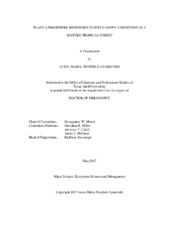| dc.description.abstract | Spatial and temporal variation in wet canopy conditions following precipitation events can influence processes such as transpiration and photosynthesis, which can be further enhanced as upper canopy leaves dry more rapidly. As part of a larger study aimed at improving land-surface modeling in a wet tropical forest of Costa Rica, this dissertation: I) compared transpiration among trees with exposed and shaded crowns under various leaf wetness conditions; II) evaluated responses of seven tropical and three semiarid savanna plant species to simulated leaf wetness; and III) tested stomatal and canopy conductance model performance while canopies were wet. To address these goals, I mainly relied on 43 sap flux sensors (Js), gas exchange measurements under dry and wet conditions, and one year and a half of micrometeorological measurements from a 40-m tower inside a mature rainforest plot.
Overstory trees (13% of the plot) contributed ~76% to total stand transpiration. Transpiration and Js was driven by vapor pressure deficit and solar radiation, but leaf wetness had a significant role by reducing as much as 28%. Dry days had equal quantities of Js between overstory and midstory trees; while on wet days, all trees had low Js rates. Meanwhile, photosynthetic responses (Anet) while leaves were wet varied greatly among species, but all plants maintained a baseline of activity. Anet responses, among all ten species, varied between -48% and +21%, when compared to their dry condition performance. Due to the canopy and atmospheric complexity of the study site, most canopy models tested did not depict leaf wetness periods appropriately. Even iii during dry days, low vapor pressure deficits interfered with model accuracy. Also, intermittent rain, during semi-dry and wet days, caused large fluctuations in canopy and stomatal conductance estimates, especially between shaded and sunlit leaves.
Thus, this dissertation found compelling evidence that leaf wetness may partially or substantially suppress physiological responses in function of leaf anatomy and intercanopy microclimate. Therefore, further studies on tropical plant traits across a wide range of species, and on leaf-level gas exchange and sap flow measurements are needed to improve the accuracy of climatic modelling of wet tropical ecosystems. | en |


